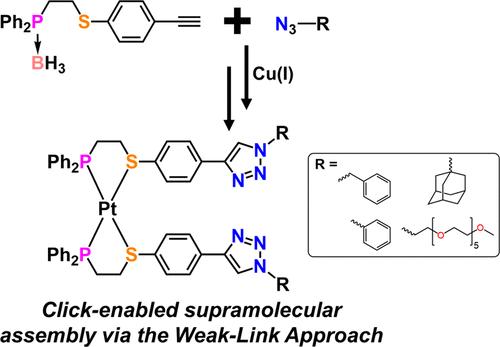通过弱链接方法通过可点击半可配体进行模块化超分子组装
IF 4.7
2区 化学
Q1 CHEMISTRY, INORGANIC & NUCLEAR
引用次数: 0
摘要
为了开发一种适合生成变构配位配合物的广泛的半可溶配体的收敛方法,制备了含垂链炔基的磷硫醚半可溶配体并将其用作合子。这些被用来通过Cu(I)催化叠氮化物-炔环加成生成四种不同的具有所需化学官能团的半可溶配体(点击化学)。这种点击化学方法的配体合成使得从PtCl2(1,5-环二烯)快速制备Pt(II)配合物成为可能。所得到的配合物可以用氯(Cl -)作为小分子效应器进行变构调节。概念验证的配合物表明,配位的可切换性与配体的空间体积、电子和配合物的溶解度无关。采用基于WLA(弱链接方法)的配位化学方法合成了同源和杂寡配位配合物,并在溶液中进行了表征。其中两种配合物(苯基和苯基衍生物配体的完全螯合均寡化配合物)也通过单晶x射线衍射研究在固态下进行了表征。这些进展扩大了可通过WLA获得的化合物的结构多样性,并且考虑到点击化学的通用性和官能团耐受性,促进了具有定制功能的变构体系的制备,用于催化和小分子传感。本文章由计算机程序翻译,如有差异,请以英文原文为准。

Modular Supramolecular Assembly through Clickable Hemilabile Ligands via the Weak-Link Approach
In an effort to develop a convergent method for synthesizing a wide range of hemilabile ligands suitable for generating allosteric coordination complexes, phosphino-thioether hemilabile ligands bearing pendant alkyne groups were prepared and employed as synthons. These were used to generate four distinct hemilabile ligands with the desired chemical functionalities via Cu(I)-catalyzed azide–alkyne cycloaddition (click chemistry). This click chemistry approach to ligand synthesis enables the rapid preparation of Pt(II) coordination complexes from PtCl2(1,5-cyclooctadiene). The resulting complexes can be allosterically regulated using chloride (Cl–) as a small-molecule effector. Proof-of-concept complexes demonstrate that coordination switchability is independent of the ligand’s steric bulk and electronics and the solubility of the complex. Both homo- and heteroligated coordination complexes were synthesized using WLA (weak-link approach) coordination-chemistry-based methods and fully characterized in solution. Two of these complexes (the fully chelated homoligated complexes of the benzyl and phenyl derivative ligands) were also characterized in the solid state by single-crystal X-ray diffraction studies. These advances expand the structural diversity of compounds accessible through the WLA and, given the generality and functional group tolerance of click chemistry, facilitate the preparation of allosteric systems with tailored functionalities for applications in catalysis and small-molecule sensing.
求助全文
通过发布文献求助,成功后即可免费获取论文全文。
去求助
来源期刊

Inorganic Chemistry
化学-无机化学与核化学
CiteScore
7.60
自引率
13.00%
发文量
1960
审稿时长
1.9 months
期刊介绍:
Inorganic Chemistry publishes fundamental studies in all phases of inorganic chemistry. Coverage includes experimental and theoretical reports on quantitative studies of structure and thermodynamics, kinetics, mechanisms of inorganic reactions, bioinorganic chemistry, and relevant aspects of organometallic chemistry, solid-state phenomena, and chemical bonding theory. Emphasis is placed on the synthesis, structure, thermodynamics, reactivity, spectroscopy, and bonding properties of significant new and known compounds.
 求助内容:
求助内容: 应助结果提醒方式:
应助结果提醒方式:


